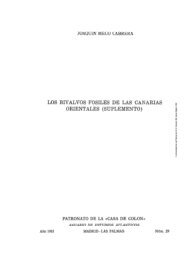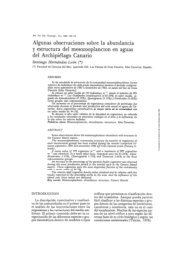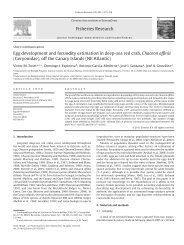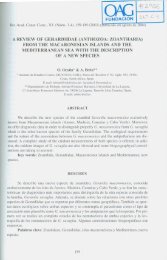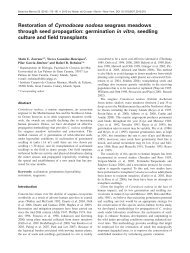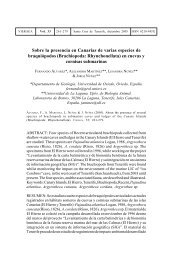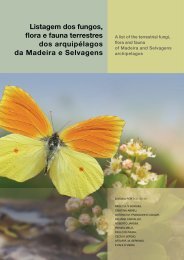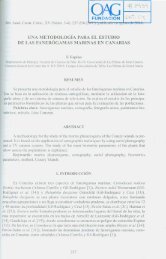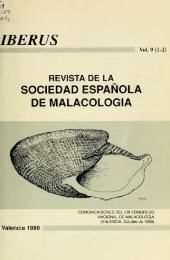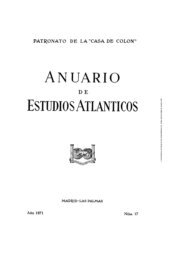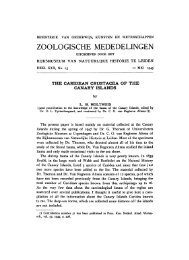Discoloraciones por acumulaciones de la diatomea ... - redmic
Discoloraciones por acumulaciones de la diatomea ... - redmic
Discoloraciones por acumulaciones de la diatomea ... - redmic
You also want an ePaper? Increase the reach of your titles
YUMPU automatically turns print PDFs into web optimized ePapers that Google loves.
52<br />
se caracterizan <strong>por</strong> su ten<strong>de</strong>ncia a formar discoloraciones producidas <strong>por</strong> <strong>de</strong>nsas<br />
<strong>acumu<strong>la</strong>ciones</strong> <strong>de</strong> célu<strong>la</strong>s, que le confieren al agua <strong>de</strong> mar y a <strong>la</strong> espuma <strong>de</strong> <strong>la</strong>s rompientes<br />
un característico color ver<strong>de</strong> oscuro o marrón (Gayoso & Muglia, 1991). Unas<br />
pocas especies <strong>de</strong> <strong>diatomea</strong>s han sido citadas como responsables <strong>de</strong> <strong>la</strong> formación <strong>de</strong><br />
estas <strong>acumu<strong>la</strong>ciones</strong> en p<strong>la</strong>yas <strong>de</strong> arena. Entre el<strong>la</strong>s <strong>de</strong>staca, Attheya armatus, especie<br />
bentónica epipsámica (Crawford et al., 2000). Estas <strong>acumu<strong>la</strong>ciones</strong> <strong>de</strong> <strong>diatomea</strong>s<br />
sólo se producen en p<strong>la</strong>yas <strong>de</strong> arena, lo que pue<strong>de</strong> ser <strong>de</strong>bido a su modo <strong>de</strong> vida<br />
epipsámico y a una hidrodinámica particu<strong>la</strong>r <strong>de</strong> <strong>la</strong>s rompientes. En general, se trata <strong>de</strong><br />
p<strong>la</strong>yas disipativas o intermedias, <strong>de</strong> pendiente suave, con amplias zonas <strong>de</strong> rompientes<br />
<strong>de</strong> alta o mediana energía, con aguas cálidas o temp<strong>la</strong>das y con arenas <strong>de</strong> grano<br />
fino (Gayoso & Muglia, 1991; Garver & Lewin, 1981). En <strong>la</strong>s <strong>acumu<strong>la</strong>ciones</strong>, <strong>la</strong>s<br />
<strong>diatomea</strong>s se adhieren a <strong>la</strong>s burbujas generadas <strong>por</strong> <strong>la</strong>s o<strong>la</strong>s y, posteriormente, se<br />
acumu<strong>la</strong>n en <strong>la</strong> superficie <strong>de</strong> <strong>la</strong> espuma, a consecuencia <strong>de</strong> <strong>la</strong>s revolturas, giros y<br />
<strong>de</strong>más movimientos <strong>de</strong>l agua <strong>de</strong> <strong>la</strong>s o<strong>la</strong>s en su discurrir <strong>por</strong> el intermareal (Lewin &<br />
Schaefer, 1983).<br />
Hasta el momento, sólo se han <strong>de</strong>scrito seis especies <strong>de</strong> <strong>diatomea</strong>s causantes <strong>de</strong><br />
<strong>la</strong> formación <strong>de</strong> discoloraciones (Du Preez & Campbell, 1997): Anaulus australis Drebes<br />
et Schulz; Asterionel<strong>la</strong> socialis Lewin et Norris, Asterionellopsis g<strong>la</strong>cialis<br />
(Castracane) Round; Au<strong>la</strong>codiscus kittonii Arnott; Au<strong>la</strong>codiscus africanus Cottam<br />
y Attheya armatus (T. West) Crawford.<br />
En este trabajo presentamos <strong>la</strong> <strong>de</strong>tección, <strong>por</strong> primera vez en p<strong>la</strong>yas <strong>de</strong> Canarias,<br />
<strong>de</strong> <strong>acumu<strong>la</strong>ciones</strong> <strong>de</strong> A. armatus, no sólo <strong>por</strong> el interés científico que ello conlleva<br />
sino <strong>por</strong>que <strong>la</strong>s <strong>acumu<strong>la</strong>ciones</strong> <strong>de</strong> <strong>diatomea</strong>s <strong>de</strong> rompientes, en <strong>la</strong>s p<strong>la</strong>yas <strong>de</strong> baño,<br />
pue<strong>de</strong>n ser muy l<strong>la</strong>mativas y <strong>de</strong>spiertan el interés y <strong>la</strong> preocupación pública, al atribuirse<br />
<strong>la</strong>s discoloraciones a contaminación <strong>por</strong> aguas residuales o, en otros casos, a<br />
manchas <strong>de</strong> grasa, lo cual ha sido recogido también <strong>por</strong> otros autores (Halcrow, 2000;<br />
Hewson et al., 2001; Du Preez & Campbell, 1997; Ifremer, 2003).<br />
Tab<strong>la</strong> I. Distribución tem<strong>por</strong>al <strong>de</strong> <strong>la</strong> presencia <strong>de</strong> <strong>acumu<strong>la</strong>ciones</strong> en p<strong>la</strong>yas arenosas <strong>de</strong>l S y<br />
SW <strong>de</strong> Gran Canaria (is<strong>la</strong>s Canarias).



